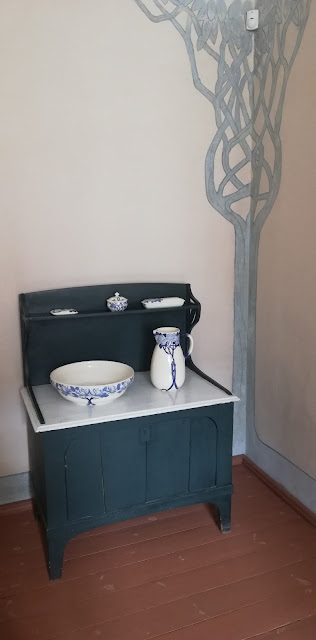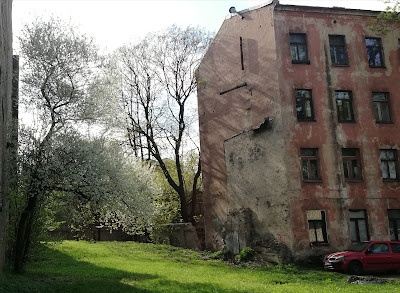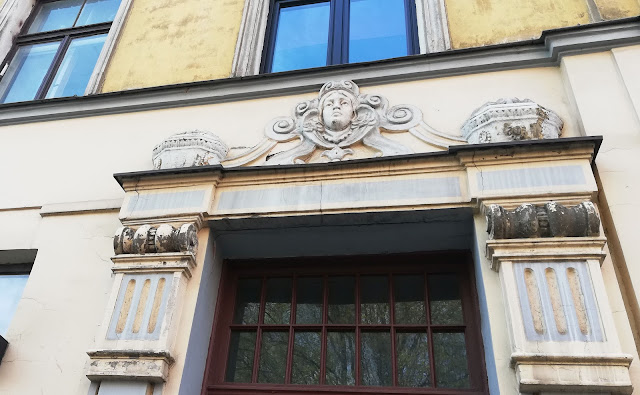The no 7 tram takes me from the suburbs into the city’s heart. The marketplace, the train station, Riga’s old town. Where I am staying is not so far from the centre but far enough to view en route some soviet era apartment blocks. My street, Katoli iela, has mostly old buildings with art nouveau carved facades above the doorways, with flaking paint, a little grimy and uncared for, but still visible.
Alongside some bright new modern buildings. And on the other side of the street, two grand and lofty red brick churches (one Catholic and one Orthodox) surrounded by a park, a green and peaceful area, with paths bordered by trees just coming into leaf.
Alkenaja Iela, where the Photography Museum is – dwindles away in front of you, cobblestones and white facades, a lure impossible to resist, & there is one tree, with young green leaves on its dropping branches, leaning over, it too beckons. But I did resist, I went to the Photography Museum and afterwards I was too tired, I had walked through many streets and climbed lots of stairs and I headed to the tram stop at the other side of the canal from the bus station, and took the No 7 tram home.
The Photography Museum has a heavy entrance door, a solid wooden slab – the handle turned, it opened and then there is a flight of wooden curving stairs, creaking as I climb up. There are certain terrains I find, that you sink into with recognition, or relief, or both, as if your whole being had been waiting for these sensations and perceptions and you had not realised how much you missed them until they present themselves again – these curving stairs, the sound of the floorboards responding to my weight like some living being, the feeling of history embedded in the wooden steps, the age of them, the love, the lastingness. And in the exhibition room, the wooden parquet floor is arranged with a star pattern at the centre. This is part of another time, one I recognize. This time stretches across Mitteleuropa – and this is the furthest north east I have encountered it. Other times brashly try to cover up the past – because they are new and present, they are the latest model of creation, the dernier cri of times, the brightest and the best, like the young woman in the Tourist Information who could not be more helpful, and the young woman in the bookshop whose English is excellent and expression, disdainful.

But what if all times are still living, as architecture and particularly museums have a way of suggesting? The woman at the desk in the Photography Museum moves slowly and carefully, counts out my change, prints out my receipt and hands it to me, and the expression on her face is of composed sadness. I’m the only visitor – another woman switches on the lights in the exhibition room.
Dorothy Bohm [born Dorothea Israelit] was the photographer exhibited. Born in then Konigsberg, Germany in 1925 – and sent for safety to the UK as a teenager and is now British. Or was as I discover she only died this year, 98 years old. You can read about her life here.
Her photos catch astonishing expressions on people’s faces, body language, of warmth, curiosity, excitement. She travelled a lot – her photos are of Israel, Italy, France, Greece, USA and England of course.
 |
| Detail from one room of the Rozentals & Blaumanis Museum |
In the Rozentals & Blaumanis Museum in the Art Nouveau Centre, the older woman by the desk had a similar containment to her energy as the one in the Photography Museum – and a sense of sorrow and of suffering. What were the lives of these people like, all of the years of their youth spent under communism in the Soviet Union? Now they have to learn new ways of being and thinking and acting and new technologies and a new language too. And here she is, guardian and attendant of this shrine to the artist Janis Rozentals and writer Rudolfs Blaumanis who lived in this attic apartment and both of whom died early in the 20th century. Curving staircases here too, right up to the top floor where the Rozental family lived.




Comments